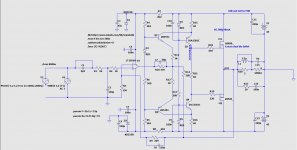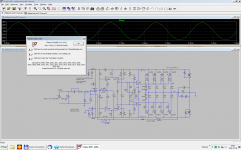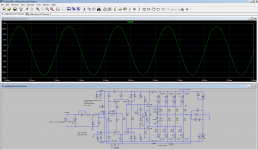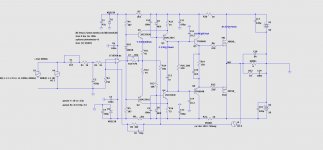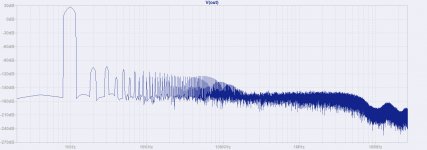Within last 2 years,I built several amps based on the LMK (Lomakin and Parshin) design, described in this thread.
I also built amp based on Philips AH578, which has this advantage (?) that it has symmetrical VAS (push-pull), and higher slew rate.
This amp here is supposed to combine both designs into one.
My primary objective was to built symmetrical (and faster) LMK amp, but either I couldn't make them stable, or their parameters were not satisfactory.
This one seem to be ok ,at least in the sim.
As usual (for LMK/Wiederhold amps from 'Unusual amp thread'), there is an op-amp at the input.
Any feedback or suggestions for improvement?
Screenshots for Thd and FFT are for 1kHz and for 20kHz.
Update 30 Aug 2021:
Actual amp has been built and tested.
Schematic attached to the 1st post is outdated.
Final, the most up-to-date schematic in the post #111.
PCB1: post #123
PCB2: post #109
Update 07 Sep 2021:
Final and completed amp - post #126.
I also built amp based on Philips AH578, which has this advantage (?) that it has symmetrical VAS (push-pull), and higher slew rate.
This amp here is supposed to combine both designs into one.
My primary objective was to built symmetrical (and faster) LMK amp, but either I couldn't make them stable, or their parameters were not satisfactory.
This one seem to be ok ,at least in the sim.
As usual (for LMK/Wiederhold amps from 'Unusual amp thread'), there is an op-amp at the input.
Any feedback or suggestions for improvement?
Screenshots for Thd and FFT are for 1kHz and for 20kHz.
Update 30 Aug 2021:
Actual amp has been built and tested.
Schematic attached to the 1st post is outdated.
Final, the most up-to-date schematic in the post #111.
PCB1: post #123
PCB2: post #109
Update 07 Sep 2021:
Final and completed amp - post #126.
Attachments
-
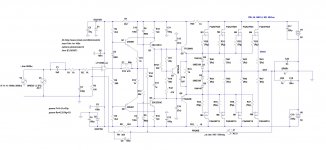 phillips.lmk.jun20.hex.jpg295.9 KB · Views: 1,419
phillips.lmk.jun20.hex.jpg295.9 KB · Views: 1,419 -
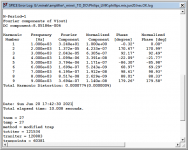 1kHz_Thd.png24.6 KB · Views: 1,540
1kHz_Thd.png24.6 KB · Views: 1,540 -
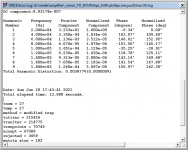 20kHz_Thd.png25.3 KB · Views: 1,280
20kHz_Thd.png25.3 KB · Views: 1,280 -
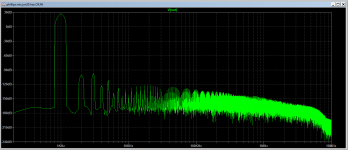 fft_1kHz.png25.3 KB · Views: 1,256
fft_1kHz.png25.3 KB · Views: 1,256 -
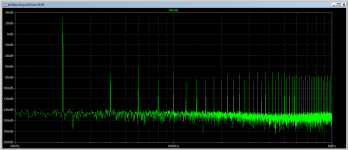 fft_20kHz.png25.9 KB · Views: 1,211
fft_20kHz.png25.9 KB · Views: 1,211 -
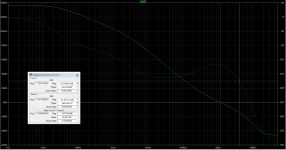 open_loop_margin.png54 KB · Views: 295
open_loop_margin.png54 KB · Views: 295 -
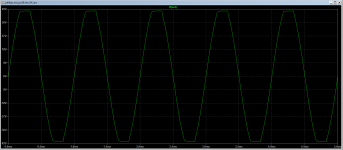 clipping.png24.1 KB · Views: 439
clipping.png24.1 KB · Views: 439 -
phillips.lmk.jun20.hex.asc16 KB · Views: 199
Last edited:
ok, why that op-amp? it seems to be a version of the LF356 with slightly better offset behavior. The 356 was an ok audio amp in its time but there are better ones around. It benefits from negative rail bootstrapping to reduce common mode input distortion if you really want to stick to it.
What is the advantage of using dual folded cascodes over e.g. using current mirrors driven by the supplies of the op-amp?
What is the advantage of using dual folded cascodes over e.g. using current mirrors driven by the supplies of the op-amp?
One of the reasons - because this op-amp model is built-in in LTSpice, and doesn't require extra files to install, so anybody can sim easily.
Op-amp is not used here as voltage amplifier (no voltage swing required), so pretty much any op-amp gives very good results; even TL071 worked great in previous amps.
Amps driven from op-amps rails are much harder to make very stable, at least from my experience.
Cascodes fulfill the function of VAS, along with input circuitry.
But it works very differently than emitter follower VAS.
See this thread for lengthy (really!) discussions about this....
More discussion (and shorter thread): comparative-vas-cascode-stage
..
Op-amp is not used here as voltage amplifier (no voltage swing required), so pretty much any op-amp gives very good results; even TL071 worked great in previous amps.
Amps driven from op-amps rails are much harder to make very stable, at least from my experience.
Cascodes fulfill the function of VAS, along with input circuitry.
But it works very differently than emitter follower VAS.
See this thread for lengthy (really!) discussions about this....
More discussion (and shorter thread): comparative-vas-cascode-stage
..
Last edited:
Ok, no output voltage swing, but the inputs will have the input signal as a common mode signal which this type of op amp does not like.
Thanks for the links about folded cascodes, will read up.
Thanks for the links about folded cascodes, will read up.
Last edited:
Use schematic from post #2.
The thing is that current flowing through pairs Q1/Q3 and Q2/Q4 should be same.
So stronger transistors are needed, like in the 2nd schematic.
This current can be modified by biasing Q1/Q2 (green led). Use Red + resistor to adjust the current, if it's not equal (approx 7ma per device).
But green led should work good.
It is true that in all my sims ever, latfet amps never measure better than hexfets.
That's normal. Question is does it translate into real builds? Many people claim that Latfets 'sound better'.
And finally, 3rd observation - by using drivers EVEN for latfets - the amps will sim better, and sound better, even though technically drivers are not required.
Quick test - take schematic from post #2, replace fets, adjust idle current, and see the results. Compare versions with drivers and without drivers.
The thing is that current flowing through pairs Q1/Q3 and Q2/Q4 should be same.
So stronger transistors are needed, like in the 2nd schematic.
This current can be modified by biasing Q1/Q2 (green led). Use Red + resistor to adjust the current, if it's not equal (approx 7ma per device).
But green led should work good.
It is true that in all my sims ever, latfet amps never measure better than hexfets.
That's normal. Question is does it translate into real builds? Many people claim that Latfets 'sound better'.
And finally, 3rd observation - by using drivers EVEN for latfets - the amps will sim better, and sound better, even though technically drivers are not required.
Quick test - take schematic from post #2, replace fets, adjust idle current, and see the results. Compare versions with drivers and without drivers.
Last edited:
The original sim file from post #2? Or after your modifications?
I just retested - for me it works perfectly..
Usually if Spice takes forever to calculate things, it's a sign some strange instability..
Or idle current being way to small...
I just retested - for me it works perfectly..
Usually if Spice takes forever to calculate things, it's a sign some strange instability..
Or idle current being way to small...
Attachments
Last edited:
I just retested - for me it works perfectly..
Usually if Spice takes forever to calculate things, it's a sign some strange instability..
My version date: DEC 21. 2020. Now its time to update. 😉
LT Spice updated. Simulation works, however if I decrease the input AC from 1.2V to 0.5V runs an endless calculation again. #2 file, unmodified.
Last edited:
There is something screwy somewhere. It works for me fine, with AC 0.5V input (image).
It also works with 0.1V...
Meantime I rebuilt the #2 version from #1, now works perfectly. Very good distortion profile, even at 20kHz. I'll try design the LATFET version with drivers.
Last edited:
It's do-able to make Thd lower, and/or FFT profile look better, but it's not easy to make it stable at the same time...
I have always really liked this design. It may have been designed to minimise costs by reducing parts count, but it has some wonderful tricks in it and the masterful connection of the IC is something I have not seen before.
HD
HD
I wonder how well it'd work with a BJT output stage.. I have some MJL4281/4302 burning a hole in my bench waiting for such a project, and I always liked the idea of using an opamp in the frontend
I wonder how well it'd work with a BJT output stage.. I have some MJL4281/4302 burning a hole in my bench waiting for such a project, and I always liked the idea of using an opamp in the frontend
Check out 'unusual amp' thread.
The first amp built - with this topology - was a BJT version.
Great amp, with unusual bias/idle current control - but this can be replaced by traditional one, like in this one.
I always liked the idea of using an opamp in the frontend
Russian diyers also like it. Many of their amplifiers have opamp in the frontend. In this case, the opamp works as an AC buffer and a DC servo, so its type is not very critical.
Last edited:
- Home
- Amplifiers
- Solid State
- HexFet Amp Based on Philips AH578 and LMK

